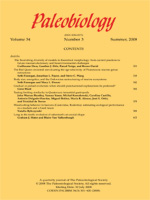Growth rings of Mesozoic fossil woods have often been used for paleoclimatological inferences. Most of the studies, however, rest upon uniformitarian deductions based on the observation of conifers from the present boreal temperate realm, whereas warm climates dominated during the Mesozoic. We propose a new approach, based on the study of the distribution of growth ring types among 643 samples from the Jurassic–Cretaceous interval. A clear picture emerges from analysis, consistent with what is known of Mesozoic climates from other sources. Woods with no rings are encountered in a wide latitudinal zone, extending up to 75°N and 65°S during the Late Cretaceous. Woods with well-developed latewood do not occur at low latitude and disappeared from the Northern Hemisphere during the Late Cretaceous. Our data set also shows that the taxonomic distribution of growth ring types is not regular. Among the genera encountered, 40% can build only one type of ring. The genus Agathoxylon never displays thick latewood, although it ranges from 75°S to 70°N. This demonstrates that growth ring studies must include a taxonomic analysis.
How to translate text using browser tools
1 September 2001
Are Mesozoic wood growth rings climate-induced?
Anne-Lise Brison,
Marc Philippe,
Frédéric Thevenard
ACCESS THE FULL ARTICLE

Paleobiology
Vol. 27 • No. 3
September 2001
Vol. 27 • No. 3
September 2001




